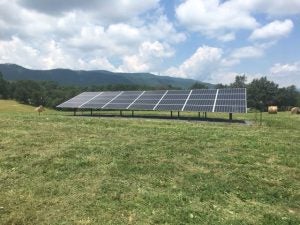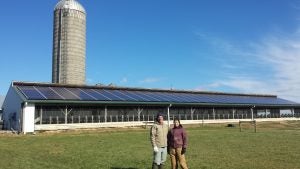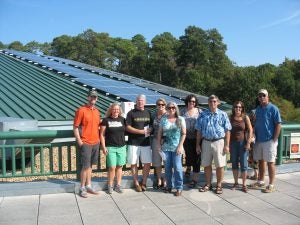Solar for municipalities
Solar energy benefits us all. It saves money. It creates local jobs. It strengthens our energy system. Municipalities are well-positioned to benefit from going solar.
View our recorded webinar. Leaders from Florida show what they’ve done to build consumer education and sustainable living in their communities.
Why go solar?
Powering schools, libraries, municipal office buildings, and maintenance centers requires a lot of energy. Going solar can benefit municipalities in many ways. Below are some highlights:
Cost savings: Solar is now cheaper than buying power from the grid in most places across the country. Solar costs have fallen more than 60%. Electricity costs are on the rise. Municipalities can invest solar savings elsewhere in the budget
- Job creation: The solar industry now employs more than 250,000 people. Solar jobs are diverse. They range from installation to manufacturing to sales. Municipalities fuel job creation by installing solar.
- Local economic development: Going solar can help municipalities jump-start the local clean energy economy. You can use the installation to educate constituents about renewable energy. This grows the local customer base for solar. Municipalities can also boost local clean energy employment. Choose local contractors for installation. Lastly, solar keeps money local. You pay less to out-of-state utility holding companies.
- Sustainability commitments: Installing solar can help your municipality meet its sustainability goals. You do so by lowering your fossil fuel consumption.
- Resiliency: Many municipalities are considering solar plus storage. This allows you to keep service during power outages. These projects are often designed to protect the most vulnerable residents in times of crises. See the Clean Energy States Alliance for more on this topic.: As battery technology drops in price, many municipalities are considering solar plus storage to use during power outages. These projects are often designed to protect the most vulnerable citizens in times of crises. See the Clean Energy States Alliance for more on this topic.
Getting started

Municipalities can go solar several ways. You can install panels on a single site. You can install them on a fleet of buildings. Our Solar FAQ will help you understand solar basics.
It provides information about:
- solar technology,
- installation procedures,
- costs, and
- incentives.
Municipalities can choose from two models of ownership:
- direct ownership
- third-party ownership
Direct ownership
Under direct ownership, the municipality pays for and owns all solar PV equipment. You take the full financial value of the electricity produced by the panels.
Third-party ownership
With third-party ownership, a separate entity owns the solar panels. The municipality pays that company for the electricity produced by the panels. Municipalities pay two separate electric bills under third-party ownership. You pay one to the utility company and one to the third-party solar owner.
Power Purchase Agreements (PPA) are the most common third-party arrangement. Download Solar Power Purchase Agreements: A Toolkit for Local Governments. It provides a step-by-step guide on how to pursue a solar PPA. Check out the Clean Energy States Alliance website. It provides extensive resources on clean energy for municipalities.
What to look for when going solar
Things to consider:
- Tax-exempt status: The Inflation Reduction Act of 2022 allows municipalities to make use of federal solar tax credits. The credit is set at 30%. It will remain at 30% until 2032. It declines to 22.5% in 2033 and 15% in 2034. It sunsets in 2035. Municipalities don’t pay taxes. The law allows them to earn the credit through a direct pay option. The IRA also introduced additional credits that will be available to municipalities. Some projects may qualify for a tax credit more than the base amount above such as:
- 10% for projects located in energy communities (eligibility mapping tool, U.S. Dept. of Energy)
- Communities that contain brownfields
- Communities that are economically disadvantaged, particularly if they previously relied on fossil fuel jobs
- 10% for projects using defined minimums of domestic content for equipment
- Note: Credits above only apply to systems that are smaller than 1 MW. Larger projects can also access the 30% base ITC, as well as these adders. But, they must meet certain labor requirements. For projects over 1 MW that do not meet those requirements the base and adder values are reduced.
- By application and approval, there are also other adders available for certain projects under 5 MW:
- 10% for selected projects located in low-income communities or on, tribal lands (map tool)
- OR 20% for selected “Qualified Low-Income Residential Building Projects” (eligible housing) OR “Qualified Low-Income Economic Benefit Projects” (See “Program Resources” section on DOE site for more info)
- 10% for projects located in energy communities (eligibility mapping tool, U.S. Dept. of Energy)
- Project time frame: Installing solar for a municipality will take longer than it would for an individual home. Municipalities have many stakeholders. They will all need to take part in the process. The project lead should communicate with fellow municipal offices and staff about the installation in its early phases. This will help you to avoid hold-ups down the line.
-

Solar can work in a variety of settings. Long-term project timeframes: With numerous departments, stakeholders, and staff teams involved in a municipality’s solar installation process, the installation timeframe will be longer than for an individual home. It is important for the municipal project lead to communicate with fellow municipal offices and staff about the installation in its early phases, to avoid hold-ups down the line. Bringing together environmental, facilities, permitting, communications, and education departments at the outset of the solar planning process will help streamline the work process and maximize engagement across all municipal offices.
- Opportunity for constituent participation: Municipal governments are uniquely situated to leverage their PV installation(s) to their constituents’ interest in going solar. Through their listservs, email blasts, and community programming, municipalities can help their residents see solar in action and learn how it can benefit their businesses and households.
Alternative solar project models for municipalities:
You don’t have to install solar on your buildings to increase solar in your community. You can help your residents go solar on their homes. Partner with Solar United Neighbors. We’ll work with you to launch a local solar co-op. Solar co-ops bring together interested homeowners. Solar co-ops are free to join. Joining isn’t a commitment to buy a system.
We educate co-op members about solar. They learn about solar economics, technology, and the process to go solar. Once the group is large enough, we solicit a bid on the group’s behalf to local installers. Installers bid. Co-op members select one company to serve the group. The chosen installer develops personalized proposals for each co-op member. Members decide individually if going solar is right for them. As of 2022, we’ve helped more than 7,500 families across the country go solar. Check out our’ solar co-op model.
Launch a municipal property assessed clean energy (PACE) financing program
Municipal governments can help their residents go solar by enacting a Property Assessed Clean Energy (PACE) program. PACE programs connect building owners with long-term, low-cost financing for energy upgrades. These upgrades can include solar installations. The building owner pays off PACE financing over time. They pay through an additional charge on their property tax. PACE financing makes energy upgrades cash-flow positive from day one. This is because the annual PACE repayments are lower than the energy savings associated with the project. Your municipality can pursue PACE programs for its constituents if your state allows PACE financing. Pace Nation tracks the states with PACE programs. Visit our PACE financing page for more information about municipal PACE programming.

Aggregate demand through Community Choice Aggregation (CCA)
Community Choice Aggregation (CCA) is a third way to encourage more solar. Under CCA, municipalities aggregate their residents’ electrical demand. Municipalities buy electricity through direct contracts with energy producers. Residents then have a choice. They can continue buying their electricity from the utility. Or, they can buy it from the municipality.
CCA is a way to help communities use more renewable energy than what may be available from the utility. Presently, only a few states have legislation that allow for CCA. Only one state, California, has operational CCA programs.
For an overview of the California program, check out UCLA’s study: “The Promises and Challenges of Community Choice Aggregation in California”.
